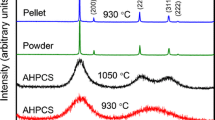Abstract
Thermal cycling (between 1340 °C and 1480 °C) experiments were conducted using two types of reaction-bonded (siliconized) silicon carbide. A commercial material (CrystarTM) and various silicon carbide pieces that had been joined together using electrophoretic deposition (EPD) followed by reaction bonding were evaluated. During the thermal cycling, residual “free” silicon metal rapidly vaporized from the CrystarTM and cracks developed within its large SiC grains. In contrast, the EPD/reaction-bonded silicon carbide joints did not lose an observable amount of their residual silicon nor develop cracks. The reduced loss was attributed to reduced silicon content with the silicon residing largely in closed pores of the EPD layer. Reduced vaporization of the silicon that resided in surface-connected pores was engineered by applying a thick SiC surface coating. The morphology of the resulting coating was microscopically evaluated and two sequential growth mechanisms were postulated. An implication of this research is that hermetic (gas-tight) joints could be formed using EPD-derived SiC as a filler material.
Similar content being viewed by others
References
B. H. Rabin, Mater. Sci. Eng. A230 (1990) L1.
M. Singh, J. of Mater. Sci. Lett. 17 (1998) 459.
B. H. Rabin and G. A. Moore, J. Mater. Synthesis and Proc. 1 (1993) 195.
Norton/St. Gobain Electronics, 1 New Bond Street, Worcester, MA 01615–0136.
P. Sarkar and P. S. Nicholson, J. Am. Ceram. Soc. 79 (1996) 1987.
P. A. Lessing, A. W. Erickson and D. C. Kunerth, J. of Mater Sci., accepted.
Carbon Lampblack # C-198, Fisher Scientific Co., 711 Forbes Ave., Pittsburg, PA, 15219.
Grade 7 × 99 from Cummings-Moore Graphite Co., 1646 North Green Ave., Detroit, MI, 48209.
Cerac Grade # S-1169 (10 micron measured mean particle size), Cerac Inc., Box 1178, 407 N. 13th St., Milwaukee, WI, 53233.
C. Hermann, Starck Inc., 280 Park Avenue, New York, N.Y., 10017.
Dimethyl ketone product # A18–4, Fisher Scientific Co., 711 Forbes Ave., Pittsburg, PA, 15219.
Butylamine, 99% Product # B8,898–5, Aldrich Chemical Co., 1001 West St. Paul Ave., Milwaukee, WI, 53201.
Silicon Lump <5 cm, 99.9995% (incl. 20–20000 ppm Sb), Lot # L03D08-ECMS# 02310, Alfa Aesar Chemical Company, 30 Bond Street, Ward Hill, MA 01835–8099.
Media Cybernetics L.P., 8484 Georgia Avenue, Silver Spring, MD, 20410 (phone 301–495–3305).
M. S. Newkirk and J. Weinstein, U.S. Patent No. 4,826,643 (1989).
G. W. Hallum and T. P. Herbell, Advanced Ceramic-Materials 3(2) (1988) p. 171.
Author information
Authors and Affiliations
Rights and permissions
About this article
Cite this article
Lessing, P.A., Erickson, A.W. & Kunerth, D.C. Thermal cycling of siliconized-SiC at high temperatures. Journal of Materials Science 36, 1389–1394 (2001). https://doi.org/10.1023/A:1017555507345
Issue Date:
DOI: https://doi.org/10.1023/A:1017555507345




